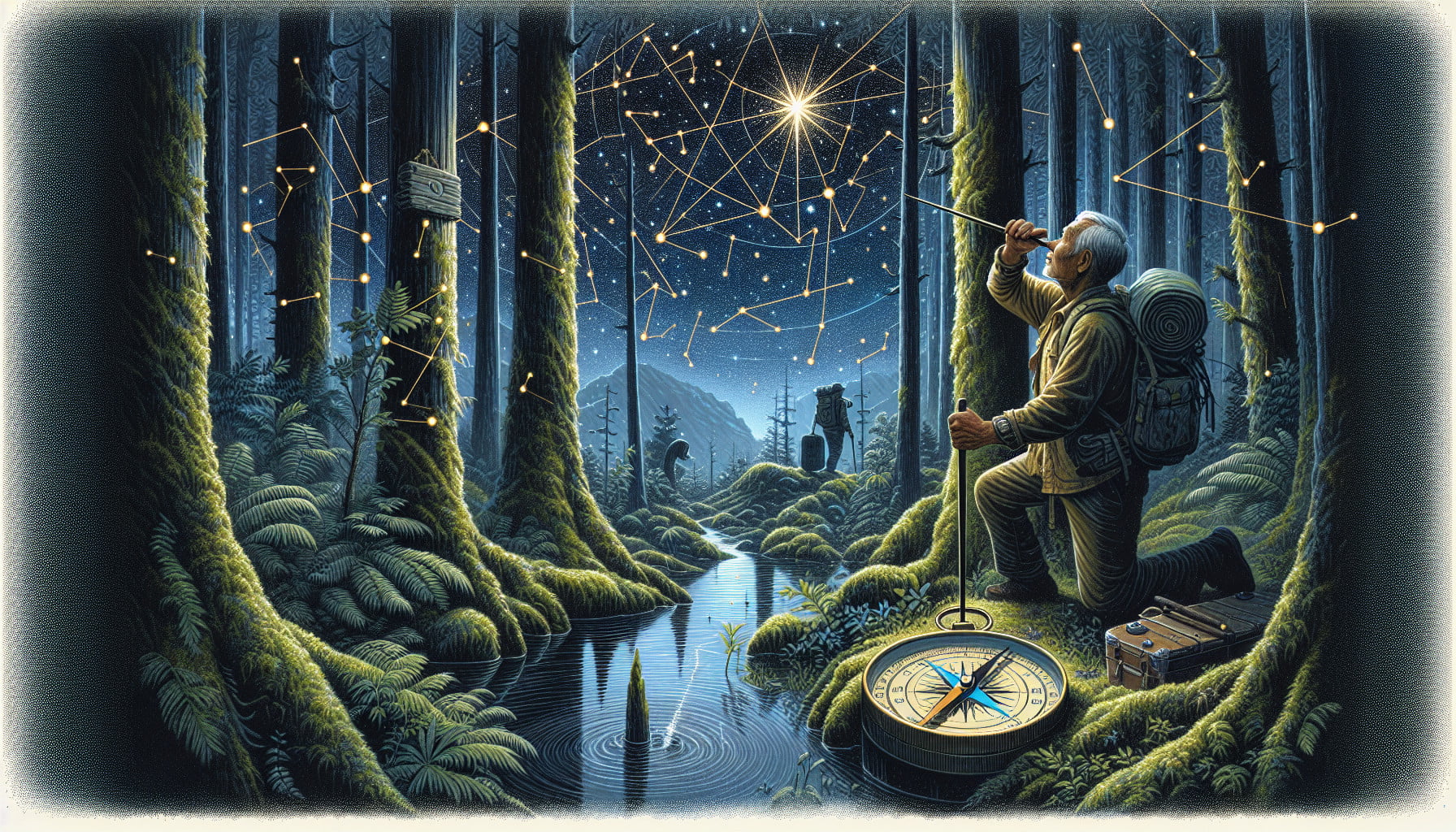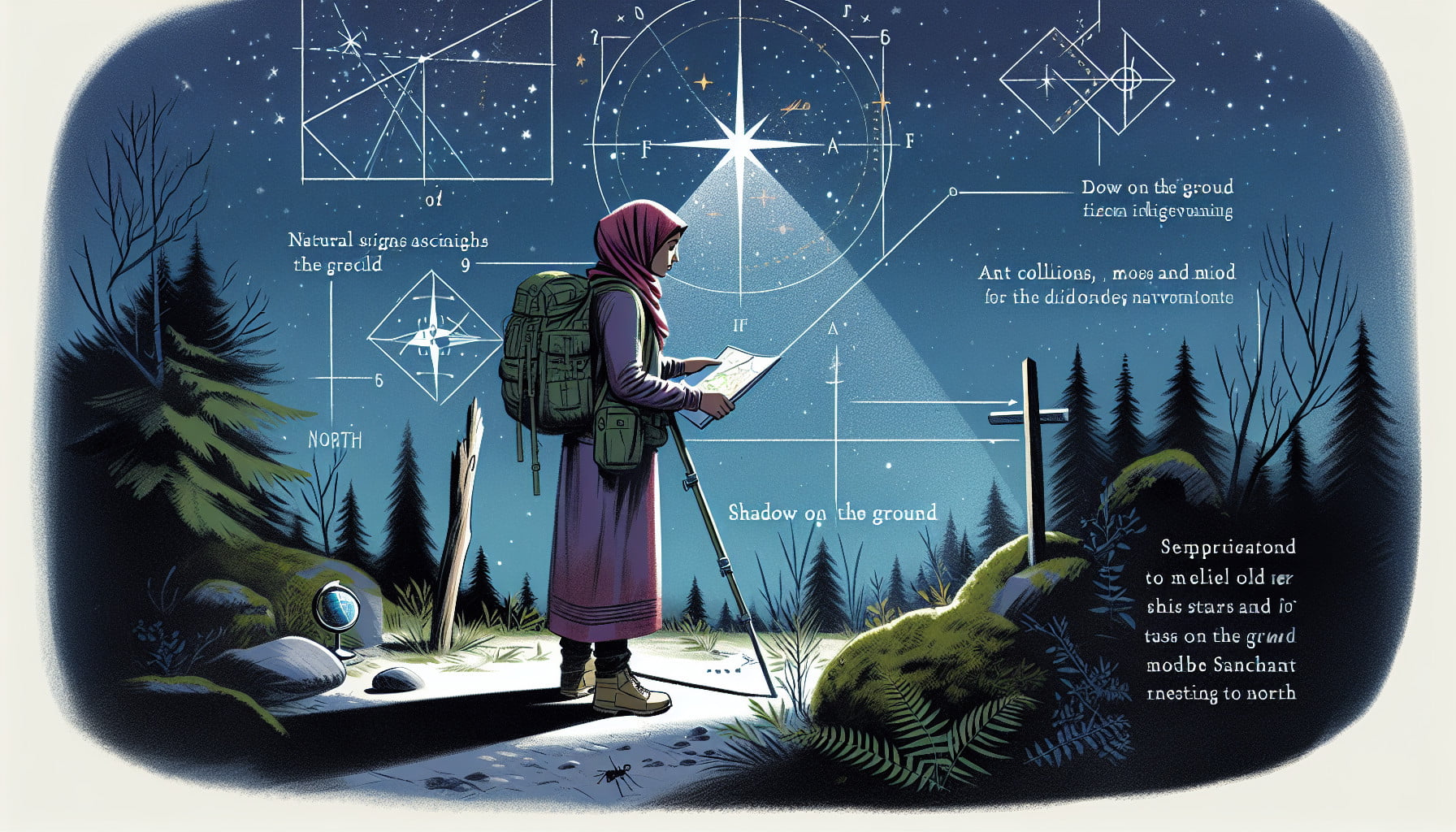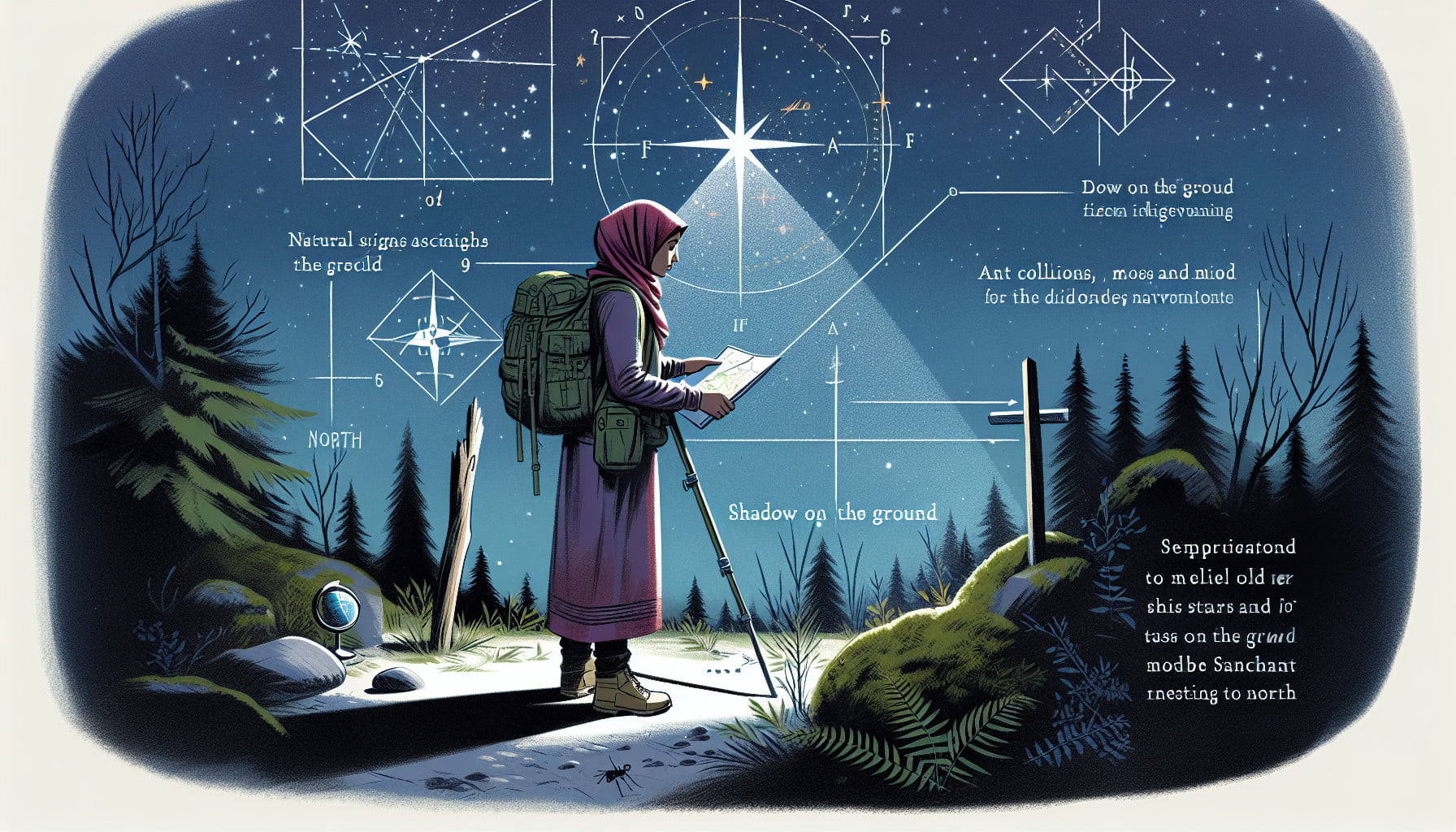Imagine you find yourself lost in the wilderness with no compass, relying solely on your instincts and resourcefulness to find your way back to civilization. In these situations, having the knowledge and skills to navigate without a compass can be invaluable. In this article, we will explore the top 5 ways to navigate without a compass, equipping you with essential techniques to guide you towards your destination using nature’s cues. Whether you enjoy hiking, camping, or simply want to be prepared for any unforeseen circumstances, mastering these navigation methods will ensure you never lose your way again.
Celestial Navigation
Using the Sun
One of the most common and reliable methods of celestial navigation is using the sun. When the sun is visible, you can determine your approximate direction by observing its position in the sky. In the northern hemisphere, the sun rises in the east and sets in the west. By noting the sun’s position at different times of the day, you can gauge your general direction of travel. For example, if the sun is directly overhead, it means you are heading south.
Using the Moon
Similar to using the sun, you can navigate using the moon’s position in the sky. The moon follows a predictable path across the night sky, making it an excellent guide for direction. Pay attention to the moon’s crescent shape and its orientation to determine whether you are heading north or south. If the crescent is facing right, you are likely heading north, while a crescent facing left indicates south. Additionally, the moon can help you estimate the time of night and approximate your location.
Using the Stars
Stars have guided sailors and travelers for centuries. By observing the stars, you can determine your direction. The North Star, also known as Polaris, is particularly useful for navigation. Locate the Big Dipper constellation, and imagine a line extending through the two stars at the end of the dipper’s bowl. This line will lead you directly to the North Star. By knowing the North Star’s position in the sky, you can determine your direction of travel. Other constellations and stars can also provide valuable navigational aids.
Nature Navigation
Using Moss on Trees
If you find yourself lost in a forest, you can use moss on trees to navigate. Moss usually grows on the north side of trees, as it prefers shaded and moist areas. By observing the presence and thickness of moss, you can determine the general direction of north. Keep in mind that this method might not be entirely accurate in areas with consistent sunlight or if the trees on the landscape have moss on all sides.
Using Wind Direction
If you need to navigate across open terrain, paying attention to wind direction can be helpful. Typically, prevailing winds blow from the west, so if you feel the wind on your face, you are likely heading east. Similarly, if you feel the wind at your back, you are most likely traveling west. However, be aware that local weather conditions and topographical features can influence wind patterns, so use this method as a general guide.
Using Shadows
Another nature-based navigation technique involves using shadows. The direction of shadows changes throughout the day due to the sun’s movement across the sky. By observing where the shadows fall relative to your position, you can determine the cardinal directions. For example, if your shadow falls to your left in the morning, you are most likely facing north. As the day progresses, the position of your shadow will change, allowing you to adjust your direction of travel accordingly.

Animal Navigation
Following Birds
Birds are known for their navigation skills and often migrate over long distances. If you find yourself lost in an unfamiliar area, paying attention to bird behavior can provide insights into your surroundings. Birds tend to follow specific migration routes, so following their flight path can lead you to a nearby water source, a comprehensive landmark, or a human settlement. Additionally, birds often roost and nest near sources of food, so their presence can indicate the presence of edible plants or other essential resources.
Following Fish
If you are near a body of water, observing fish behavior can assist in navigation. Fish tend to swim towards the nearest source of food or shelter. By identifying their movement patterns, you can infer the location of underwater structures, such as reefs or submerged vegetation. Additionally, the presence of certain fish species might indicate specific environmental conditions. For instance, trout prefer cold and clean water, while catfish are more commonly found in muddy or warmer waters.
Following Insects
Insects, such as bees and ants, have specialized navigation abilities and can navigate significant distances from their nests in search of food and resources. When lost, observing the movement and behavior of insects can provide valuable information about your surroundings. Ants, for example, leave scent trails to guide them back to their nest. By following their trail, you might come across a nearby landmark or find a more well-traveled path. Paying attention to the buzzing of bees can also lead you to a source of water, as they are attracted to moist areas.
Landmarks and Terrain Navigation
Using Natural Landmarks
Nature provides an array of natural landmarks that can serve as navigational aids. Mountain ranges, rivers, lakes, and coastlines are prominent features that can guide you in the right direction. By identifying these landmarks in your surroundings, you can determine your approximate location and adjust your course accordingly. Additionally, distinct geological formations like cliffs, valleys, or unique rock formations can act as reference points, helping you stay on track.
Using Man-Made Structures
In addition to natural landmarks, man-made structures can also assist in navigation. Roads, buildings, bridges, and power lines are visible signs of human activity and can provide valuable orientation. While navigating, keep an eye out for these structures and use them as reference points. When following a road, for example, you can use it to maintain a consistent direction of travel. Similarly, identifying unique buildings or landmarks can help you determine your approximate location.
Using Terrain Features
Understanding the terrain and topographical features of your surroundings can greatly aid in navigation. Valleys, hills, ridges, and even vegetation patterns can serve as reliable indicators of direction. For example, water tends to flow downhill, so by following a river or stream, you can generally find your way to lower ground. Additionally, certain plants, like moss or tree branches, may bend or lean in a particular direction due to prevailing winds or sunlight, providing clues about your path.

Timekeeping and Direction Navigation
Using Shadows and Sun Movement
By observing the movement of shadows and the position of the sun, you can estimate both the time of day and your approximate direction. In the northern hemisphere, shadows tend to grow shorter as the day progresses, with the longest shadows appearing in the morning or afternoon. You can also use a stick in the ground to create a makeshift sundial and track the changing position of the shadow throughout the day. By aligning the shadow with the corresponding hour markings, you can determine the approximate time and adjust your navigation accordingly.
Using North Star and Constellations
The North Star, also known as Polaris, has been used for centuries as a reliable navigation guide. To locate the North Star, look for the constellation known as the Big Dipper, and imagine a line extending through the two stars at the end of the dipper’s bowl. This line will lead you directly to the North Star, which resides in the constellation Ursa Minor. By knowing the North Star’s position in the sky, you can determine true north and navigate accordingly. Other constellations and stars can also provide navigational guidance, depending on the time of year and your location.
Using a Sundial
A sundial can be a useful tool for both timekeeping and direction navigation. By aligning the sundial’s gnomon (the vertical stick that casts the shadow) with the sun’s position, you can accurately tell the time of day. Sundials come in various designs, such as portable models or those that are permanently installed in gardens or public places. If you find a sundial, make sure the gnomon is oriented to the current time, and use it as a reference point to adjust your navigation based on the sun’s movement.
Nautical Navigation
Using Tides and Currents
For those navigating on the water, tides and currents can provide essential navigational information. Tidal charts and tables provide accurate predictions of the height and timing of tides and can help determine safe passage through shallow areas or harbor entrances. Additionally, currents can be used to your advantage by riding with them to conserve energy or strategically planning your route to minimize resistance. By understanding the local tide and current patterns, you can navigate the waters more effectively.
Using Coastal Landmarks
When navigating along the coast, identifying and using coastal landmarks is crucial for maintaining direction. Lighthouses, distinct rock formations, or prominent buildings can serve as reliable references point along the shoreline. By plotting your course based on these landmarks, you can ensure you are following the desired route and make course adjustments if needed. It is essential to have updated charts and coastal maps for accurate navigation, as well as a basic understanding of how to read them.
Using Wave Patterns
Observing wave patterns can provide useful information about your location and direction when navigating at sea. Waves are typically influenced by wind direction and the bathymetry (underwater topography) of the area. By paying attention to the direction and shape of waves, you can infer the presence of landmasses, such as islands or reefs, as well as any changes in underwater topography. Additionally, knowing how different wind speeds and directions affect wave behavior can help you determine your overall direction of travel.
Map and Compass Substitutes
Using the Stars and Constellations
When a map and compass are unavailable, the stars and constellations can serve as a substitute navigational tool. By familiarizing yourself with the night sky and identifying key constellations, you can navigate based on their positions. Using the North Star as a reference point, as mentioned earlier, can give you a general idea of which direction is north. Other constellations, such as Orion or the Southern Cross, can provide additional directional cues based on their location relative to your position.
Using Natural Navigation Techniques
Mother Nature often provides us with valuable navigational clues. By paying attention to natural signs such as the growth pattern of trees, the presence of certain animal species, or the behavior of insects, you can piece together information about your surroundings and navigate accordingly. For example, trees tend to grow taller and denser on south-facing slopes due to increased sunlight, providing a rough indication of your direction. Similarly, observing the behavior of animals, as discussed earlier, can help you find resources or locate nearby landmarks.
Body Navigation Techniques
Using the Human Body as a Compass
Believe it or not, the human body can be used as a compass in certain situations. By aligning your body with the rising or setting sun, you can determine approximate east and west directions. Stand with your left shoulder facing the direction of the sunrise (east), and your right shoulder facing the sunset (west). Additionally, by extending your arms to the sides, your left arm will point towards north and your right arm towards south. While these methods are not as precise as a compass, they can provide a general sense of direction when needed.
Using Timekeeping Strategies
Keeping track of time can also assist in navigation when a compass is unavailable. If you know the approximate distance you have traveled, you can estimate your direction based on the time it took to cover that distance. For instance, if you have been walking for a set amount of time and know your average speed, you can approximate your direction by comparing it to a known distance or landmark. Simple timekeeping strategies, such as using your pulse or the ticking of a watch, can help you maintain a consistent pace and gauge your progress.
Technology-Based Navigation Methods
Using GPS or Smartphone Apps
In today’s digital age, navigation has become more accessible than ever with the ubiquity of smartphones and GPS devices. GPS (Global Positioning System) technology allows you to pinpoint your current location using satellite signals, providing accurate positioning information. Many smartphones have built-in GPS capabilities and navigation apps that can guide you with detailed maps, turn-by-turn directions, and even offline navigation. These tools can be invaluable for both urban and wilderness navigation, providing real-time information and helping you reach your destination efficiently.
Using Maps and Online Tools
While not as technologically advanced as GPS devices, traditional paper maps and online mapping tools offer reliable navigation resources. Maps provide a visual representation of the landscape, including features such as rivers, roads, contour lines, and points of interest. By familiarizing yourself with the symbols and legends on the map, you can navigate effectively, even without a compass. Online mapping tools, such as Google Maps or Bing Maps, provide interactive maps, satellite imagery, and detailed directions, making them convenient alternatives in areas with internet access.
Emergency Navigation Techniques
Using Sunlight and Shadows
In emergency situations, when you find yourself without a compass, you can still utilize the sun and shadows for navigation. The sun rises in the east and sets in the west, providing a general reference for finding your direction. Shadows cast by objects change throughout the day due to the sun’s movement. These changing positions can help you determine the cardinal directions. Additionally, if you know the approximate time of day, you can estimate your direction by how the sunlight falls on your surroundings, such as which side is brighter or warmer.
Using the Moon and Stars
The moon and stars can be extremely helpful in emergencies, particularly during nighttime navigation. Even without a compass, aligning yourself with a known star, such as the North Star or a prominent constellation, can give you a sense of direction. The moon also follows a predictable pattern across the sky, and its position can help you determine which way to travel. By observing the moon and stars, even in challenging situations, you can increase your chances of finding safety and reaching your desired destination.
In conclusion, navigating without a compass is possible by using various methods, including celestial navigation, nature-based techniques, animal behavior observation, landmarks and terrain assessment, timekeeping strategies, nautical navigation techniques, map and compass substitutes, body navigation, technology-based approaches, and emergency navigation techniques. Each of these methods relies on different aspects of our surroundings and our ability to observe and interpret them. By learning and practicing these techniques, you can enhance your navigation skills, become more self-reliant in outdoor adventures or emergency situations, and better explore and appreciate the natural world around you.

